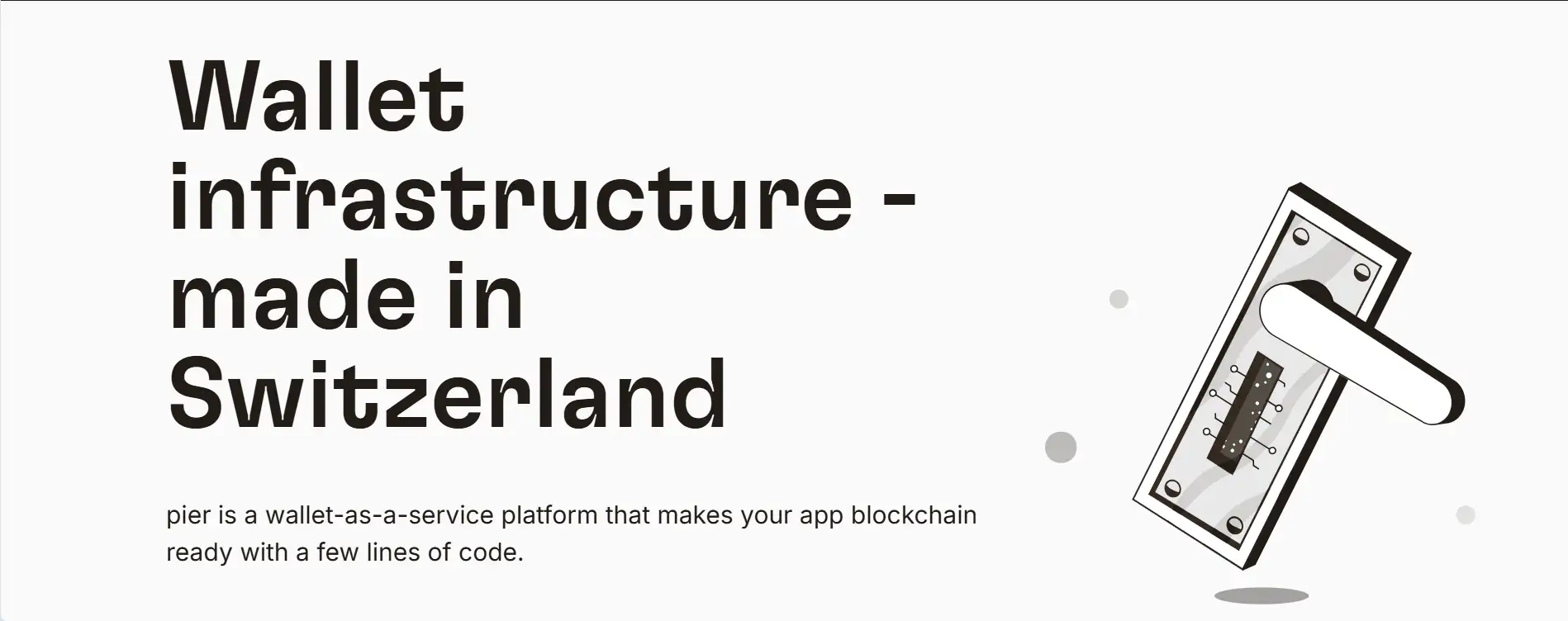About pier wallet
Pier Wallet is a Swiss-engineered wallet-as-a-service platform designed to make blockchain integration seamless, secure, and scalable for any application. Built with a deep commitment to self-custody and user-first design, Pier Wallet enables companies to embed powerful Web3 wallet infrastructure with just a few lines of code. It empowers businesses and developers to deliver an intuitive, gasless, and secure blockchain experience to users across mobile, desktop, and web platforms.
Using advanced technologies like Account Abstraction (ERC-4337), Multi-Party Computation (MPC), and Multi-Signature wallets, Pier allows developers to offer secure yet user-friendly wallets without compromising decentralization. Whether it’s an NFT marketplace, crypto gaming platform, or DeFi protocol, Pier provides the infrastructure to streamline onboarding, improve retention, and abstract away the pain points of blockchain complexity—all while upholding core Web3 principles like ownership of private keys and trust minimization.
Pier Wallet is a leading-edge platform in the Web3 infrastructure space, developed in Switzerland to deliver highly secure and customizable wallet infrastructure for applications of all sizes. Unlike generic wallets that operate as standalone applications, Pier Wallet operates as a backend service—allowing platforms to fully white-label the experience or seamlessly integrate it with their existing user flows. Its key value proposition is simplicity: making blockchain accessible and invisible to users while remaining fully non-custodial.
One of Pier’s most powerful features is its robust implementation of Account Abstraction. This technology enables users to create wallets without having to manage private keys or seed phrases. Authentication can be done via familiar Web2 methods such as social logins, biometrics, and email-password combinations. At the same time, Pier supports enterprise-grade security configurations including multi-signature wallets (n/m) and guardian-based account recovery. This makes it an ideal choice for both individual-focused apps and organizational use cases like DAOs or fintech platforms.
Pier’s unique advantage is its ability to support both EVM-compatible chains (like Ethereum and Polygon) and non-EVM chains (like Bitcoin and Cardano). On EVM chains, the platform offers a complete SDK for account abstraction; on non-EVM chains, it uses Multi-Party Computation (MPC) to deliver similar abstraction and security features. Developers can choose from API integration or SDK-based integration, with full documentation and hands-on support from the Pier team.
Use cases for Pier are broad. Projects can automate wallet creation, simplify gas fee management with paymasters, batch transactions, and enable social or authenticator-based recovery. Dashboards provide insight into user behavior, transaction metrics, and wallet activity. Companies like Muuvr, Bitwala, Daura, and Openair Frauenfeld already use Pier’s infrastructure to deliver secure and scalable crypto experiences.
In the competitive Web3 wallet space, Pier stands out by combining enterprise-level security with consumer-grade simplicity. Notable competitors include Magic.link (developer-friendly wallet SDKs), Sequence (smart wallet for games), and Web3Auth (MPC-based login service). However, Pier’s support for both EVM and non-EVM chains, combined with its strong privacy-by-design stance and full control over user keys, make it a distinctive offering in the space.
Pier Wallet provides numerous benefits and features that make it a standout in the wallet-as-a-service ecosystem:
- Plug-and-Play Integration: Integrate a fully functional Web3 wallet using simple SDKs or direct API access, with developer support and clear documentation.
- True Self-Custody: Users retain full control of their assets—no seed phrases, no platform-side custody, and no compromise on decentralization.
- Account Abstraction (ERC-4337): Eliminate blockchain complexity with gasless transactions, social logins, and simplified wallet management.
- Enterprise-Grade Security: Features include multi-sig wallets, MPC architecture, and multiple forms of account recovery, including 2FA and guardianship.
- Multi-Chain Support: Compatible with Ethereum, Polygon, Bitcoin, Cardano, and other major chains for maximum flexibility.
- White-Label Customization: Create a branded wallet experience tailored to your app, with custom content, NFT distribution, and design theming.
- Progressive Security Layers: Start with simple login and scale to full security with recovery, multisig, and gas payment management as needed.
- Live Dashboard: Monitor wallet usage, transaction volume, and user behavior directly from the built-in analytics panel.
Pier Wallet makes integrating blockchain into your app a straightforward process. Here’s how to get started with Pier:
- Visit the Website: Go to www.pierwallet.com and explore the docs, blog, and features to understand how Pier works.
- Get in Touch: Use the contact form or join their Discord to connect with the Pier team for a tailored onboarding experience.
- Choose Integration Method: Select between SDK or API depending on your team’s needs and tech stack. Full documentation is available to support your dev team.
- Configure Wallet Features: Define account abstraction settings, set recovery methods (social, guardian, authenticator), enable paymasters for gas fee coverage, and select your chain(s).
- Launch Your Wallet: Deploy your wallet frontend—either use Pier’s ready-made app or fully customize it with your branding and user flows.
- Track & Optimize: Use the dashboard to monitor usage stats and optimize wallet performance and user experience.
- Stay Updated: Follow Pier on Twitter and LinkedIn to stay informed about new features and integrations.
pier wallet FAQ
Pier Wallet leverages Account Abstraction (ERC-4337) to eliminate traditional blockchain hurdles like gas fees, seed phrases, and private key management. Users can sign in using familiar methods—such as social logins or biometrics—without even realizing they're interacting with blockchain infrastructure. Behind the scenes, paymasters handle gas fees, and automated transaction batching simplifies interactions, making Web3 feel like Web2.
Yes, Pier is built for multi-chain compatibility. It supports EVM chains like Ethereum and Polygon using Account Abstraction and non-EVM chains like Bitcoin and Cardano through Multi-Party Computation (MPC). This means developers can build unified wallet experiences that work seamlessly across both environments—offering users a truly interoperable Web3 experience.
Pier offers robust, non-custodial recovery mechanisms that do not compromise self-ownership. Users can recover their wallets via social recovery, authenticator apps, or designated guardians—without needing a seed phrase. These progressive recovery options ensure high security while maintaining a smooth user experience. Visit pierwallet.com to explore the recovery setup options.
Pier is fully self-custodial by design. The infrastructure ensures that users always own their keys, and companies never gain access to private keys or wallet contents. All wallet interactions happen via secure APIs or SDKs that abstract complexity without compromising decentralization. Companies get the benefit of a smooth UX without the compliance risks or liabilities of custody.
With Pier, you can either use the ready-made, white-labeled wallet app and customize it to your brand, or build your own frontend using the SDK and APIs. The white-label version is ideal for fast deployment, while custom frontend integration is perfect for teams who want complete design control. Both options offer access to all of Pier's core features like gas abstraction, MPC, and account recovery.
You Might Also Like












